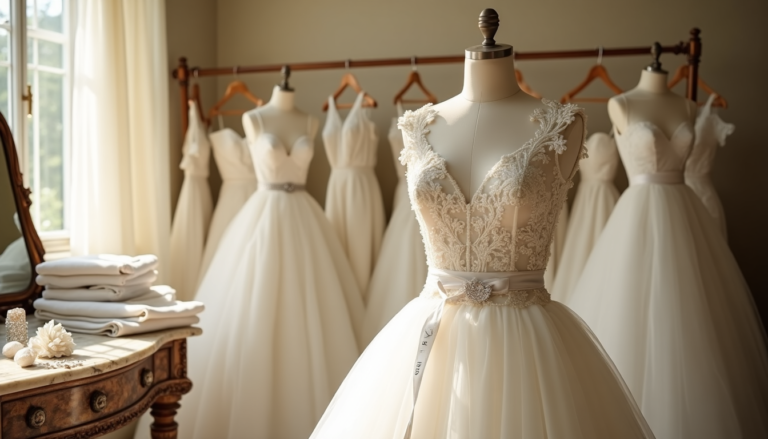Every bride dreams of wearing the perfect wedding dress on her special day. Yet, many discover that the countless racks of ready-made gowns don’t quite capture their unique vision or personal style.
A custom bridal gown offers the opportunity to create exactly what you’ve imagined, from the silhouette to the smallest detail. This personalized approach ensures your dress tells your story and reflects your personality perfectly.
Whether you’re considering local boutiques, online designers, or renowned fashion houses, designing a custom wedding dress involves crucial decisions and careful planning. This comprehensive guide walks you through each step of creating your dream dress, from choosing the right designer to incorporating meaningful details that make your gown truly one-of-a-kind.
Finding Your Perfect Wedding Dress Designer
Finding the perfect designer for your custom bridal gown is like choosing an artist to paint your portrait – they need to understand your vision, style, and personality. The journey begins with thorough research and careful evaluation of potential designers who can bring your dream dress to life.
How to research and evaluate potential designers
Start your search by exploring bridal magazines, websites, and social media platforms to identify designers whose esthetic matches your vision. Look for designers who showcase diverse styles and consistently demonstrate quality craftsmanship in their work. Pay special attention to:
- Previous custom designs and portfolio variety
- Social media presence showing real bride experiences
- Reviews and testimonials from past clients
- Range of styles and ability to work with different fabrics
- Experience with your preferred design elements
Questions to ask during initial consultations
Your first meeting with potential designers sets the foundation for your dress-creation journey. Come prepared with these essential questions:
- What is your design process from concept to completion?
- How do you handle fabric selection and sampling?
- What is the typical timeline for creating a custom bridal gown?
- Can you work within my budget of [X] amount?
- What customization options are available?
- How many fittings are included in the process?
Red flags to watch out for
Being aware of potential warning signs can save you time, money, and heartache. Be cautious if you encounter:
Lack of transparency about costs is a major red flag. A reputable designer will be upfront about pricing, including the base cost, alterations, and any additional fees for customization. Watch out for de
signers who deflect budget discussions or pressure you into making quick decisions.
Contract clarity is crucial. Be wary of designers who gloss over contract details or refuse to provide clear written agreements. Every aspect of the design process, from timeline to alterations, should be clearly documented.
Pay attention to how the designer communicates. If they’re dismissive of your ideas or push their vision without considering your preferences, it might indicate future collaboration challenges. The right designer will balance their expertise with your desires, creating a collaborative environment where your dream dress can come to life.
Remember that sample sales and trunk shows can be excellent opportunities to meet designers and see their work firsthand, but don’t feel pressured to make an immediate decision. The right designer will respect your need to carefully consider this important choice.
Navigating the Design Process
The journey of creating your custom bridal gown begins once you’ve selected your designer. This exciting process transforms your vision from initial concept to a stunning reality through careful planning and artistic collaboration.
Initial concept development and sketching
The creative process begins with inspiration gathering. Your designer will encourage you to share images, sketches, or ideas that capture your dream dress elements. Bring everything that inspires you – from magazine clippings to family heirlooms that hold special meaning.
During the initial design consultation, your designer will translate your ideas into preliminary sketches. This collaborative process allows for creative exploration while ensuring your vision remains at the heart of the design. The sketches will detail:
- Silhouette and overall structure
- Neckline and back details
- Sleeve options and length
- Train style and embellishments
- Special design elements unique to your vision
Fabric selection and sampling
Selecting the perfect fabric is crucial for bringing your custom bridal gown to life. Your designer will guide you through various options, considering factors such as:
- Season and venue requirements
- Desired silhouette and draping
- Comfort and movement needs
- Budget considerations
- Embellishment compatibility
Popular fabric choices include silk, satin, lace, and tulle, each bringing unique characteristics to your design. Your designer will likely recommend ordering fabric samples to help you understand how different materials look and feel before making final decisions.
Fittings and adjustments timeline
A well-planned fitting schedule ensures your custom bridal gown fits perfectly for your big day. Most brides require 2-3 fittings, typically spread across 8-12 weeks. Here’s a typical timeline:
First Fitting (8-12 weeks before wedding) This initial fitting focuses on basic structure and silhouette. You’ll try on a muslin mock-up, allowing for major adjustments without risking the final fabric. Your designer will pin and mark areas needing modification.
Second Fitting (4-6 weeks before wedding) Now working with your actual dress fabric, this fitting refines the fit and allows for detailed adjustments. You’ll see your vision taking shape as embellishments and special details are added.
Final Fitting (1-2 weeks before wedding) This is the moment when everything comes together. Final tweaks ensure perfect fit and comfort. Bring your wedding shoes and planned undergarments to ensure everything works in harmony.
Throughout the process, your designer will make detailed notes and adjustments, ensuring every aspect of your custom bridal gown meets your expectations. They’ll also guide you on proper posture and movement in your dress, ensuring you feel confident and comfortable on your wedding day.
Remember that creating a custom wedding dress is an organic process that may require flexibility as the design evolves. Trust in your designer’s expertise while maintaining open communication about your preferences and concerns. This collaborative approach will result in a one-of-a-kind gown that perfectly captures your bridal vision.
Making Design Decisions
Creating your dream wedding dress is about making thoughtful design choices that reflect your personality while honoring tradition. As you work with your custom bridal gown designer, several key decisions will shape your perfect dress.
Incorporating personal style elements
Your wedding dress should be a reflection of who you are. Consider these signature elements that can make your custom-made wedding dress uniquely yours:
- Neckline variations (plunging, sweetheart, or illusion)
- Sleeve designs (cap, billowy, or sheer)
- Dramatic trains or detachable overskirts
- Personal esthetic touches (subtle color accents or unique embellishments)
- Customized fabric layers that complement your body type
Balancing trends with timeless design
When designing your custom bridal gown, strike a balance between contemporary trends and enduring style. Consider this approach to combining both elements:
| Trend Element | Timeless Balance |
| Dramatic cape | Classic silhouette |
| Colored accents | Traditional white base |
| Modern cutouts | Elegant lace overlay |
| Statement sleeves | Simple bodice design |
Remember that the most successful custom-made wedding dresses blend current fashion with classic elements that will look beautiful in photos for years to come.
Working with family heirlooms and meaningful details
Transform your custom bridal gown into a treasured family legacy by incorporating meaningful elements. Consider adding your mother’s lace trim or grandmother’s vintage buttons to your design. These personal touches create a powerful connection between generations.
For a subtle approach, create a hidden “something blue” pocket where you can carry small family mementos. Your designer can also help integrate family heirloom jewelry by designing specific necklines or sleeve styles that showcase these precious pieces.
When incorporating family elements, focus on seamless integration rather than obvious additions. A skilled designer can weave these meaningful details into your dress in ways that enhance rather than overwhelm your overall vision. This thoughtful approach ensures your custom-made wedding dress honors both your personal style and family heritage while maintaining a cohesive design.

Daniel J. Morgan is the founder of Invidiata Magazine, a premier publication showcasing luxury living, arts, and culture. With a passion for excellence, Daniel has established the magazine as a beacon of sophistication and refinement, captivating discerning audiences worldwide.





